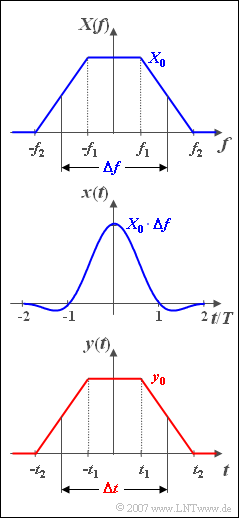Difference between revisions of "Aufgaben:Exercise 3.4: Trapezoidal Spectrum and Pulse"
| Line 41: | Line 41: | ||
| − | '' | + | ''Hints:'' |
| − | * | + | *This exercise belongs to the chapter [[Signal_Representation/Fourier_Transform_Laws|Fourier Transform Laws]]. |
| − | * | + | *Use the [[Signal_Representation/Fourier_Transform_Laws#Vertauschungssatz|Vertauschungssatz]] and the [[Signal_Representation/Fourier_Transform_Laws#Similarity_Theorem|Similarity Theorem]]. |
| − | * | + | *You can check your results using the two interactive applets [[Applets:Impulse_und_Spektren|Impulses and Spectra]] sowie [[Applets:Frequenzgang_und_Impulsantwort|Frequenzgang und Impulsantwort]] . |
| Line 51: | Line 51: | ||
| − | === | + | ===Questions=== |
<quiz display=simple> | <quiz display=simple> | ||
Revision as of 19:48, 23 January 2021
We consider here a trapezoidal spectral function $X(f)$ according to the upper graph, which is completely described by the three parameters $X_0$, $f_1$ and $f_2$ . For the two corner frequencies, $f_2 > 0$ and $0 \leq f_1 \leq f_2$ always apply.
Instead of the corner frequencies $f_1$ and $f_2$ , the following two descriptive variables can also be used:
- the equivalent bandwidth:
- $$\Delta f = f_1 + f_2,$$
- the so-called rolloff factor (in the frequency domain):
- $$r_f = \frac{ {f_2 - f_1 }}{ {f_2 + f_1 }}.$$
With these quantities, the associated time function (see middle graph) is:-
- $$x( t ) = X_0 \cdot \Delta f \cdot {\mathop{\rm si}\nolimits} ( { {\rm \pi} \cdot \Delta f \cdot t} ) \cdot {\mathop{\rm si}\nolimits} ( { {\rm \pi} \cdot r_f \cdot \Delta f\cdot t} ).$$
Here $\text{si}(x) = \text{sin}(x)/x$ is the so-called splitting function.
In this example, the numerical values $X_0 = 10^{–3}\,\text{V/Hz}$, $f_1 = 1\,\text{kHz}$ and $f_2 = 3\,\text{kHz}$ are to be used. The time $T = 1/\Delta f$ is only used for standardisation purposes. From subtask (3) a trapezoidal signal $y(t)$ is considered, which is identical in shape to the spectrum $X(f)$ .
The following can be used here as descriptive variables:
- the pulse amplitude $y_0 = y(t = 0)$,
- the equivalent pulse duration (defined via the rectangle with the same area):
- $$\Delta t = t_1 + t_2,$$
- the rolloff factor (in the time domain) with comparable definition as $r_f$:
- $$r_t = \frac{ {t_2 - t_1 }}{ {t_2 + t_1 }}.$$
Let $y_0 = 4\,\text{V}$, $\Delta t = 1\,\text{ms}$ and $r_t = 0.5$.
Hints:
- This exercise belongs to the chapter Fourier Transform Laws.
- Use the Vertauschungssatz and the Similarity Theorem.
- You can check your results using the two interactive applets Impulses and Spectra sowie Frequenzgang und Impulsantwort .
Questions
Musterlösung
- $$\Delta f = f_1 + f_2 \hspace{0.15 cm}\underline{= 4\;{\rm{kHz}}}{\rm{.}}$$
- Für den Rolloff-Faktor gilt:
- $${ {r_f = }}\frac{ {f_2 - f_1 }}{ {f_2 + f_1 }}\hspace{0.15 cm}\underline{ = 0.5}.$$
(2) Der Maximalwert des Impulses $x(t)$ tritt zum Zeitpunkt $t = 0$ auf:
- $$x_0 = x(t = 0) = X_0 \cdot \Delta f \hspace{0.15 cm}\underline{= 4\, \text{V}}.$$
- Zum Zeitpunkt $t = T = 1/\Delta f$ gilt aufgrund von $\text{si}(\pi) = 0$:
- $$x( {t = T} ) = x_0 \cdot {\mathop{\rm si}\nolimits} ( {\rm{\pi }} ) \cdot {\mathop{\rm si}\nolimits} ( { { {\rm{\pi }}}/{2}} )\hspace{0.15 cm}\underline{ = 0}.$$
- Auch bei allen Vielfachen von $T$ weist $x(t)$ Nulldurchgänge auf. Zum Zeitpunkt $t = T/2$ gilt:
- $$x( {t = T/2} ) = x_0 \cdot {\mathop{\rm si}\nolimits} ( { { {\rm{\pi }}}/{2}} ) \cdot {\mathop{\rm si}\nolimits}( { { {\rm{\pi }}}/{4}} ) = x_0 \cdot \frac{ { 1 \cdot \sqrt 2 /2}}{ { {\rm{\pi /}}2 \cdot {\rm{\pi /4}}}} = x_0 \cdot \frac{ {4 \cdot \sqrt 2 }}{ { {\rm{\pi }}^{\rm{2}} }} \hspace{0.15 cm}\underline{= 2.293\;{\rm{V}}}{\rm{.}}$$
(3) Die zum trapezförmigen Spektrum $X(f)$ zugehörige Zeitfunktion lautet entsprechend der Angabe:
- $$x( t ) = X_0 \cdot \Delta f \cdot {\mathop{\rm si}\nolimits} ( { {\rm{\pi }} \cdot \Delta f \cdot t} ) \cdot {\mathop{\rm si}\nolimits} ( { {\rm{\pi }} \cdot r_f \cdot \Delta f \cdot t} ).$$
- Da sowohl $X(f)$ als auch $x(t)$ reell sind und zudem $y(t)$ formgleich mit $X(f)$ ist, erhält man unter Berücksichtigung aller Äquivalenzen für die Spektralfunktion des Trapezimpulses:
- $$Y( f ) = y_0 \cdot \Delta t \cdot {\mathop{\rm si}\nolimits} ( { {\rm{\pi }} \cdot \Delta t \cdot f} ) \cdot {\mathop{\rm si}\nolimits} ( { {\rm{\pi }} \cdot r_t \cdot \Delta t \cdot f} ).$$
- Insbesondere gilt:
- $$Y( {f = 0} ) = y_0 \cdot \Delta t \hspace{0.15 cm}\underline{= 4 \;{\rm{mV/Hz}}}{\rm{,}}$$
- $$Y( {f = 0.5\;{\rm{kHz}}} ) = y_0 \cdot \Delta t \cdot {\mathop{\rm si}\nolimits} ( {{ {\rm{\pi }}}/{2}} ) \cdot {\mathop{\rm si}\nolimits} ( {{ {\rm{\pi }}}/{4}} ) \hspace{0.15 cm}\underline{= 2.293 \;{\rm{mV/Hz}}}{\rm{,}}$$
- $$Y( {f = 1\;{\rm{kHz}}} ) = y_0 \cdot \Delta t \cdot {\mathop{\rm si}\nolimits} ( {\rm{\pi }} ) \cdot {\mathop{\rm si}\nolimits} ( {{ {\rm{\pi }}}/{2}} )\hspace{0.15 cm}\underline{ = 0}\;{\rm{.}}$$
(4) Der Spektralwert bei der Frequenz $f = 0$ wird nicht verändert:
- $$Y_0 = y_0 \cdot \Delta t \hspace{0.15 cm}\underline{= 4 \,\rm{mV/Hz}}.$$
- Da nun aber die Zeitfunktion nur halb so breit ist, verbreitert sich das Spektrum um den Faktor $2$:
- $$Y( {f = 1\;{\rm{kHz}}} ) = Y_0 \cdot {\mathop{\rm si}\nolimits} ( {{ {\rm{\pi }}}/{2}} ) \cdot {\mathop{\rm si}\nolimits} ( {{ {\rm{\pi }}}/{4}} ) \hspace{0.15 cm}\underline{= 2.293\,{\rm{mV/Hz}}}{\rm{.}}$$
- In der Teilaufgabe (3) ist dieser Spektralwert bei der Frequenz $f = 0.5\,\rm{kHz}$ aufgetreten.
